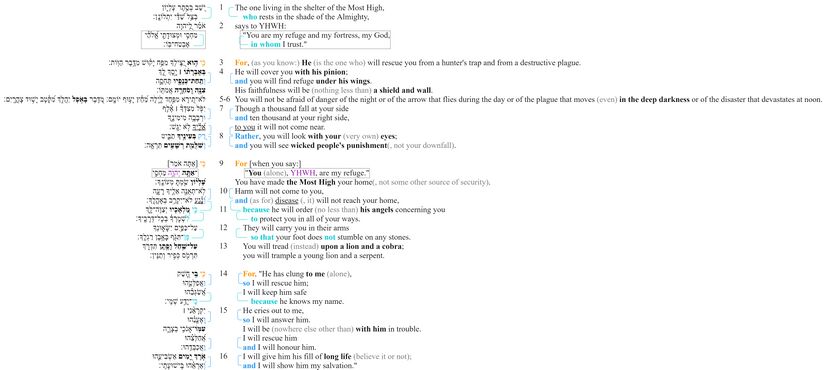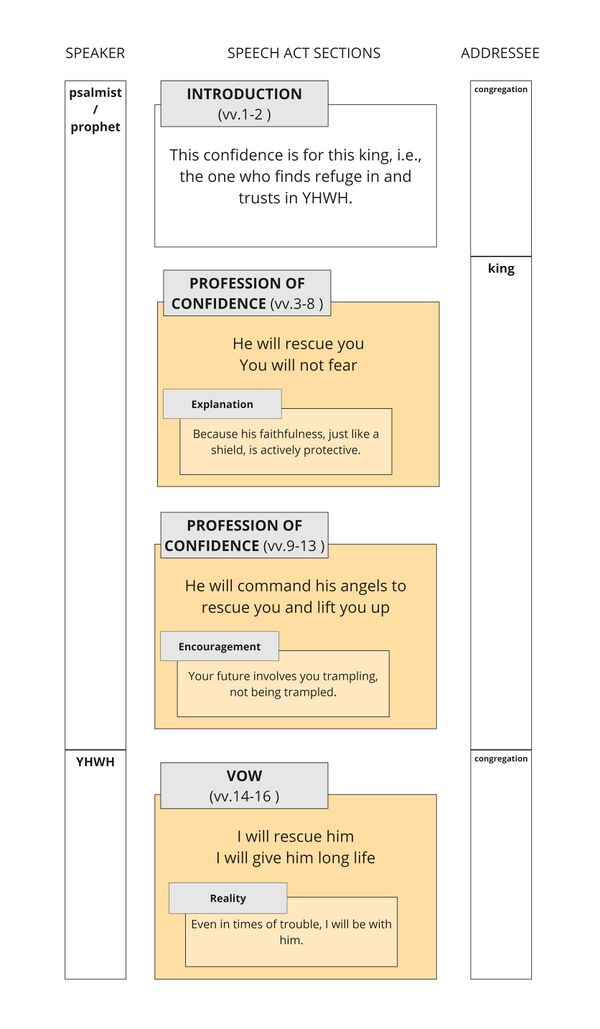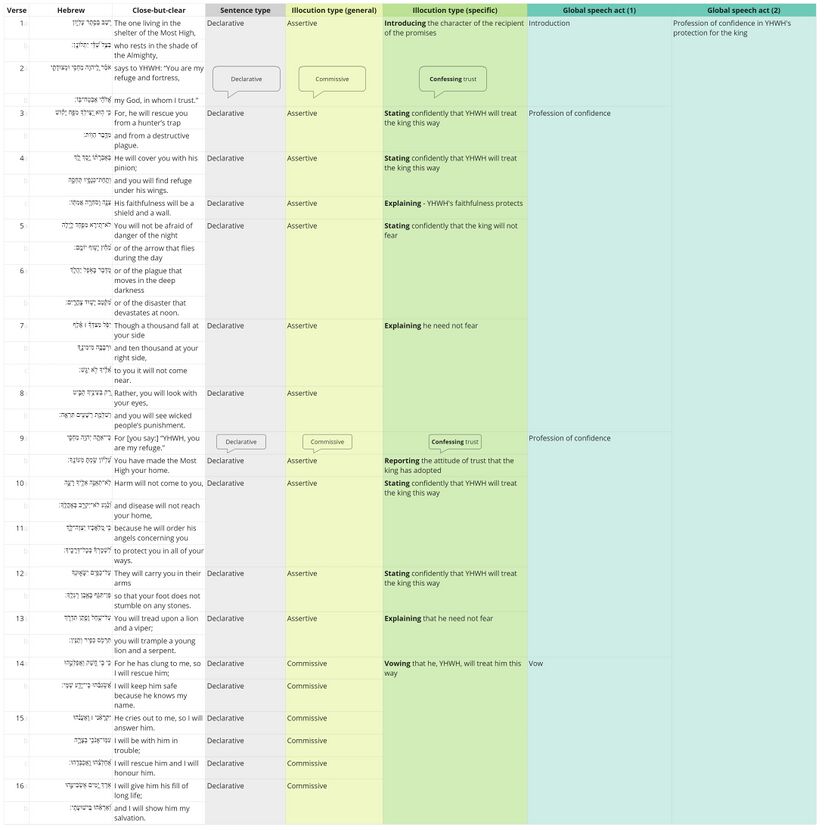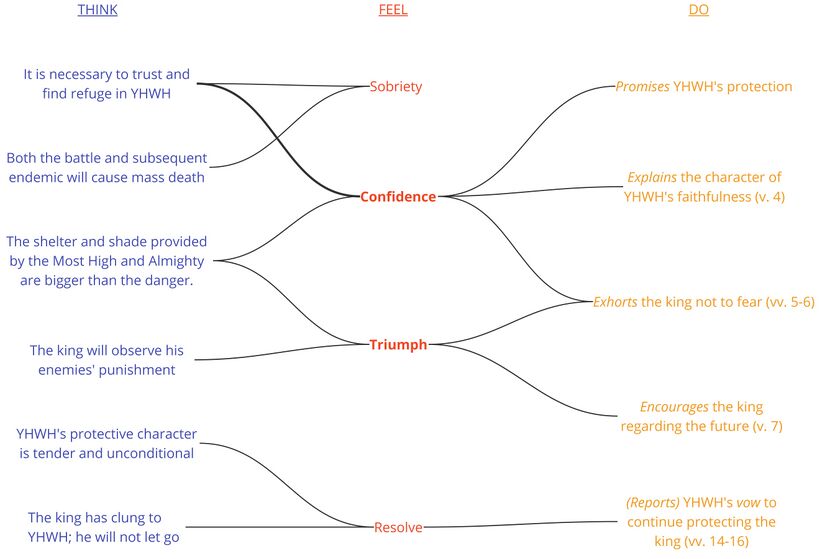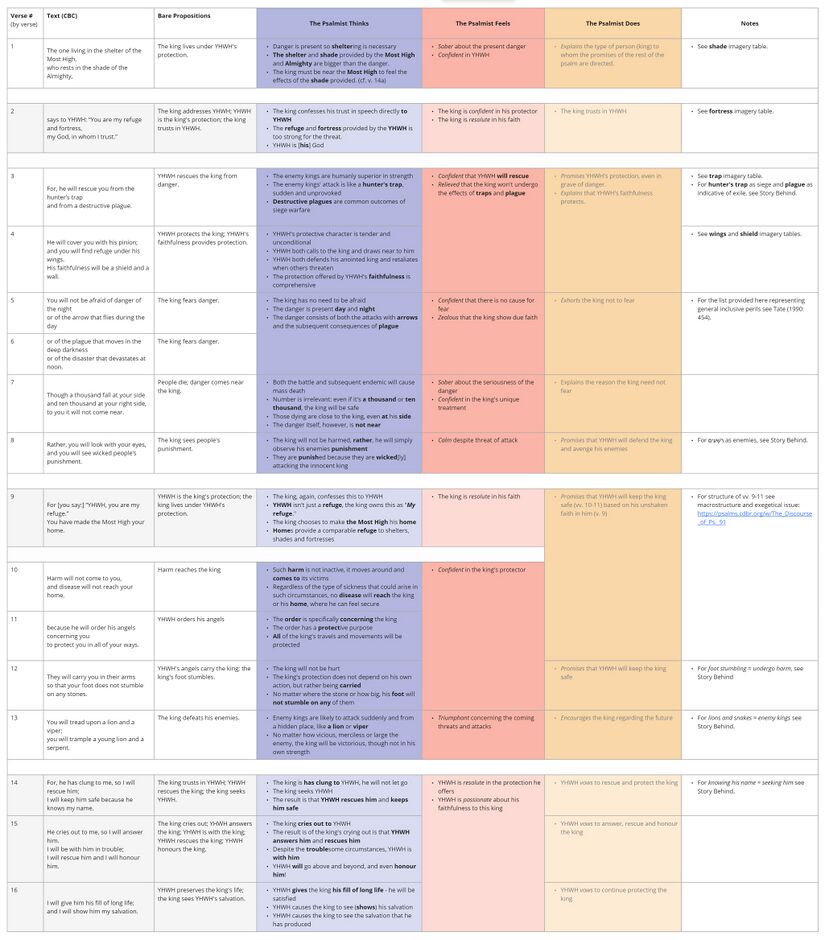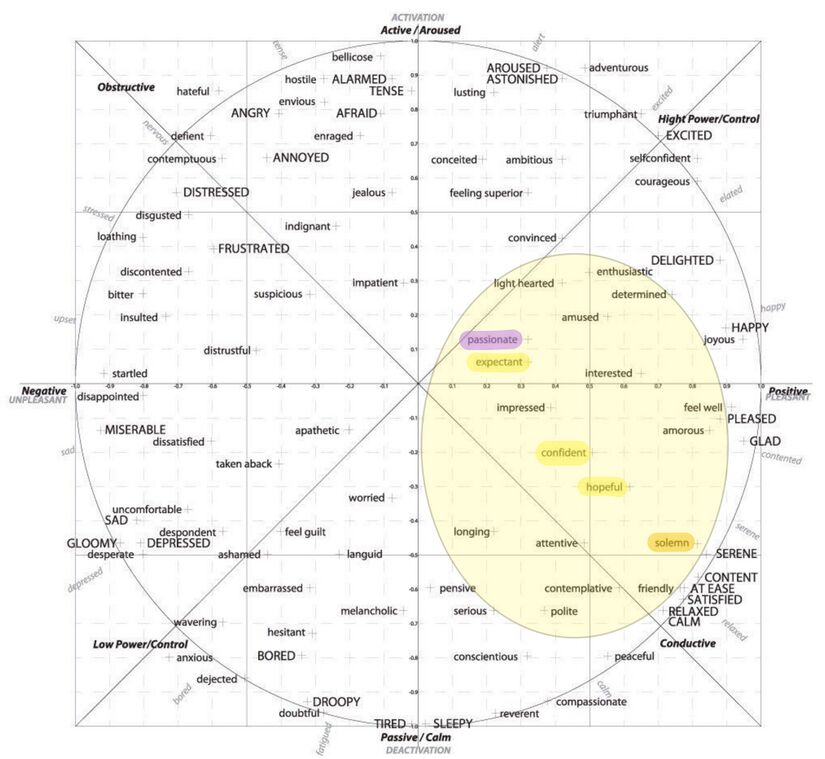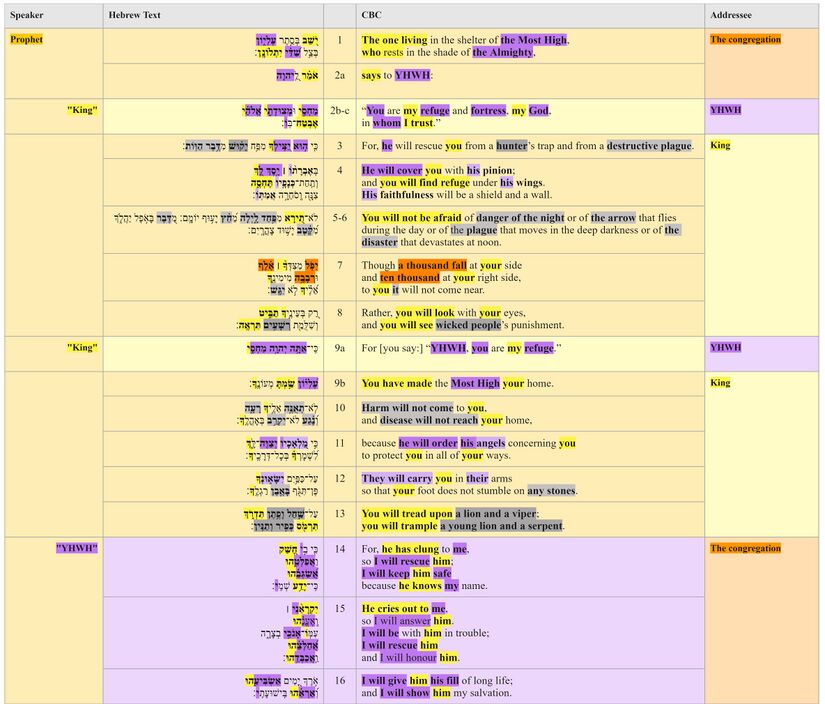Psalm 91 Discourse
About the Discourse Layer
Our Discourse layer includes four analyses: macrosyntax, speech act analysis, emotional analysis, and participant analysis. (For more information, click 'Expand' to the right.)
Macrosyntax
The macrosyntax layer rests on the belief that human communicators desire their addressees to receive a coherent picture of their message and will cooperatively provide clues to lead the addressee into a correct understanding. So, in the case of macrosyntax of the Psalms, the psalmist has explicitly left syntactic clues for the reader regarding the discourse structure of the entire psalm. Here we aim to account for the function of these elements, including the identification of conjunctions which either coordinate or subordinate entire clauses (as the analysis of coordinated individual phrases is carried out at the phrase-level semantics layer), vocatives, other discourse markers, direct speech, and clausal word order.
For a detailed explanation of our method, see the Macrosyntax Creator Guidelines.
Speech Act Analysis
The Speech Act layer presents the text in terms of what it does, following the findings of Speech Act Theory. It builds on the recognition that there is more to communication than the exchange of propositions. Speech act analysis is particularly important when communicating cross-culturally, and lack of understanding can lead to serious misunderstandings, since the ways languages and cultures perform speech acts varies widely.
For a detailed explanation of our method, see the Speech Act Analysis Creator Guidelines.
Emotional Analysis
This layer explores the emotional dimension of the biblical text and seeks to uncover the clues within the text itself that are part of the communicative intent of its author. The goal of this analysis is to chart the basic emotional tone and/or progression of the psalm.
For a detailed explanation of our method, see the Emotional Analysis Creator Guidelines.
Participant Analysis
Participant Analysis focuses on the characters in the psalm and asks, “Who are the main participants (or characters) in this psalm, and what are they saying or doing? It is often helpful for understanding literary structure, speaker identification, etc.
For a detailed explanation of our method, see the Participant Analysis Creator Guidelines.
Discourse Visuals for Psalm 91
Macrosyntax
Notes
Paragraph Divisions
- v. 3a - discourse כִּי, fronted הוּא and systematic inclusion of 2nd person addressee, following direct speech in v. 2b.
- v. 9a - discourse כִּי, potentially focussed אַתָּה, vocative and introduction of direct speech.
- v. 14a - discourse כִּי, fronted בִי and oracle of direct speech from YHWH.
Word Order
- v. 1b - the fronting seems to be primarily motivated by poetic symmetry.
- v. 3a - the fronting of הוּא as completive focus, (i.e., X will rescue you, where X =YHWH).
- v. 4a - the fronting of בְּאֶבְרָתוֹ as completive focus, i.e., how is he your refuge and fortress (v. 2), how is he going to rescue you (v. 3) (i.e., presupposition = he will rescue you in X manner).
- v. 4b - the fronting of תַֽחַת־כְּנָפָיו perhaps as completive focus, as the previous line, or, more likely, creating poetic repetition with the A-line.
- v. 4c - the reversal of צִנָּה וְסֹחֵרָה in the verbless clause probably as scalar focus.
- v. 6a - the fronting of בָּאֹפֶל probably as scalar focus.
- v. 7a-b - post-verbal מִצִּדְּךָ֨׀ אֶ֗לֶף probably to create symmetry with next clause (that is, to place אֶ֗לֶף וּרְבָבָ֥ה in escalating adjacency)
- v. 7c - the fronting of אֵלֶיךָ either as contrastive topic or contrastive focus., i.e., "as for you, it won't come near," or, "[it might come near to them but] it won't come near to you."
- v. 8a - the fronting of בְּעֵינֶךָ is difficult, but perhaps intensive focus. I take רַק as scoping over the entire clause. (If serving only as a focus particle for בְּעֵינֶךָ, how else would you look (נבט)?) But if the entire VP is scalar focus, i.e., you'll only look with your eyes (but you won't be in harm's way, like they are), why the fronting of בְּעֵינֶךָ in that case? 11QapocrPsalms reads רק תביט בעיניך, and, although the reason why is probably irrelevant (perhaps to strengthen the structural parallelism in v. 8 with two verb-initial lines), the result is רק unambiguously scoping over the whole clause of v. 8a. In conclusion, the best narrow focus reading seems to be intensive, i.e., with your very own two eyes, (not through someone else's report), which may indicate that even if the danger is close, the king will be safe nonetheless (cf. the at your side in v. 7).
- v. 8b - the fronting of שִׁלֻּמַת רְשָׁעִים probably as replacing focus, i.e., them(, not you).
- v. 9a - the identity of אַתָּה completive focus if Miller and Kim are right about the position of the vocative (see below).
- v. 9b - the fronting of עֶלְיוֹן as exclusive focus.
- v. 10b - topically-fronted נֶגַע probably also in head-tail linkage with רָעָה of previous line.
- v. 11a - the fronting of מַלְאָכָיו perhaps as replacing focus, if a human agent of rescue could have been presupposed.
- v. 12 - the fronting of עַל־כַּפַּיִם in v. 12a is most likely to create an inclusio with רַגְלֶֽךָ at the end of v. 12b, and possibly even prime its usage (as similar terms - כַּף רֶגֶל), i.e., 'instead of your sole touching a stone, their soles (palms) will carry you'. This could also explain the post-verbal בָּאֶ֣בֶן רַגְלֶֽךָ. Alternatively, נגף + ב + stone need to be adjacent for the processing of the construction.
- v. 13a - the fronting of עַל־שַׁחַל וָפֶתֶן as replacing focus in light of the previous line, i.e., you won't stub your foot on a stone (suffer), but you will trample on wild animals (make your enemies suffer).
- v. 14a - the fronting of בִי both exclusive focal and creates inclusio with שְׁמִי in v. 14d.
- v. 15c - the fronting of עִמּוֹ most probably as confirming focus.
- v. 16a - the fronting of אֹרֶךְ יָמִים possibly as scalar focus, i.e., the point is that this is even above and beyond the current deliverance.
Vocatives
- v. 9a - clause-medial, so apparently focusing the preceding entity (Miller 2010: 357; Kim 227-233), so in this case אַתָּה.
Discourse Markers
- v. 3a - discourse כִּי
- v. 8a - רַק scopes over the entire line, providing a contrast with v. 7 (see above for word order of vv. 7-8).
- v. 9a - discourse כִּי
- v. 14a - discourse כִּי
Speech Act Analysis
Summary Visual
Speech Act Chart
Emotional Analysis
Summary visual
Emotional Analysis Chart
Emotional Analysis Circumplex
Participant analysis
There are 4 participants/characters in Psalm 91:
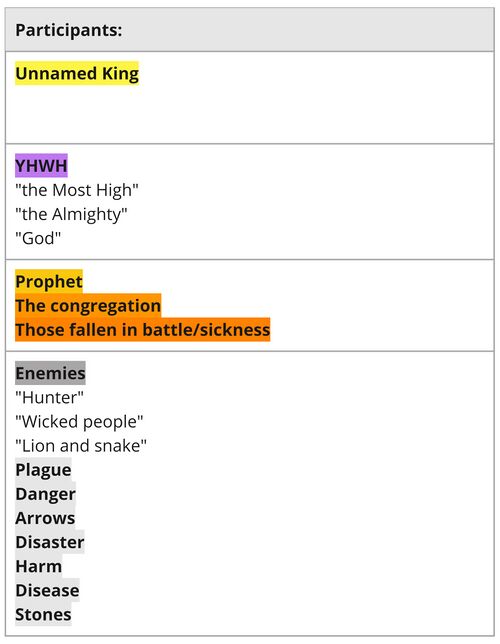
- The kingly figure is not specified, but probably a Judahite king receiving a prophetic message apparently under the threat of enemy siege attacks, the accompanying sickness and possibly defeat and exile, so an episode such as Sennacherib's attack on Jerusalem during the reign of Hezekiah is possible.
- The prophetic figure is not specified, but may be Moses' voice due to the superscription of the previous psalm and the elements of exilic threat, which Moses, as a prophet, foretold. The addressees of vv. 1-2 and 14-16 are unspecified but judged to be a congregation of the Israelite community as witnesses to the promises from YHWH towards their anointed king. Those mentioned falling in battle most likely consist of members of the same.
- The enemies in this psalm are most likely foreign kings attacking the royal city. They are described as wicked, their warfare is likened to that of a hunter and their appellation as lions and snakes also point to the identity of enemy kings. A number of their tactics of attack and the secondary effects thereof are mentioned throughout the psalm.
Participant Relations Diagram
The relationships among the participants may be abstracted and summarized as follows:
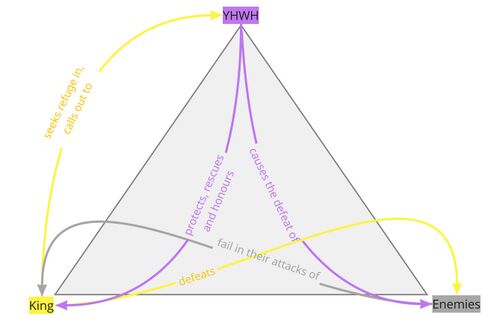
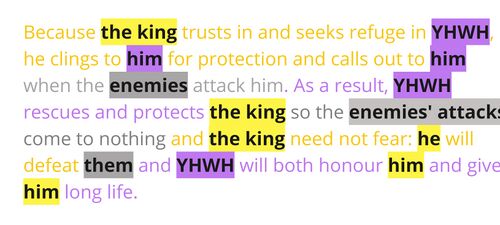
Participant Analysis Table
Notes
- Identity of speaker throughout.
- Unspecified, but some sort of prophetic character seems clear ("the speaker would be a priest or a prophet addressing the king," Tate 1990: 451), since he gives the direct words of YHWH (vv. 14-16)
- Perhaps Moses, in continuation with Ps. 90's superscription (Jerome, Homily 68), since Ps 91 lacks a superscription (except the LXX's Αἶνος ᾠδῆς τῷ Δαυιδ), and Moses is known as a prophet (Deut. 34.10).
- The content of the psalm also fits this profile, as all of plague (Deut. 28:21; 32:24), arrows (Deut. 32:23), harm (רעה; Deut. 32:23), the teeth and poison of wild animals (Deut. 32:24) are named as exilic consequences of covenant disobedience communicated by Moses. (For context of siege warfare and ensuing sickness and plague, see Story Behind).
- vv. 1-2: The identity of the addressee - Congregation or King?
- Unspecified, but presumably the same as in vv. 14-16. Probably the Israelite congregation in general.
- If, however, א–מ–ר is to be read as an imperative, the king would be the addressee; if it is to be read as a 1sg yiqtol, the king would be the speaker (see exegetical issue The Grammar and Participants of Psalm 91:2).
- vv.1-2: The identify of the referent (a thematic statement, title [Tate 1990, Goldingay 2008])
- Unspecified, but that a certain king is in view seems clear:
- The use of pi. כבד in v. 15
- The shield-like protection of YHWH (mentioned here in v. 4c) is offered for the righteous, those finding refuge in him and those who love his name (Ps. 5. 12-13; 18.31), but perhaps particularly for his covenant mediator (Gen. 14; 15.1), in whom people also find refuge (Ps. 2.12) and who thereupon provides protection for his people (Ps. 84.10).
- While dominion of creation is promised to humanity in general (Ps. 8.7), the biblical image of enemies as a footstool is reserved for the Messianic king (Ps. 110:1) and the ultimate enemy also being a snake who will be trodden on (Gen. 3:15)
- The siege warfare's effects of plague seem to point to an event similar to Sennacherib's invasion against Hezekiah (so, Theodoret of Cyrus, trans. Hill 2001; Jenkins [2023: 23]; the Peshitta's superscription; Curtis [2009: 118])
- Unspecified, but that a certain king is in view seems clear:
- vv. 3-13: The identity of the addressee
- Unspecified, but clearly the person described in vv. 1-2 : "The 'you' is promised liberation and protection. The text assumes that this is the same person as in verse 2" (Vreugdenhil 2020: 146; cf. Radak, Ibn Ezra, Erhlich 1905). For details, see above.
- v.7: The identity of the (ten) thousand:
- Either the enemies (as per the following verse) or neighbours. The latter is preferred due to the concessive nature of the clause and the endemic-like effects of being closed in a besieged city. The point, rather than victory over his enemies (which is clear throughout the psalm, especially vv. 8, 13), seems to be the special treatment of the anointed king and the fulfillment of the Davidic covenantal promises (see story behind for details).
- v. 7: The subject of יִגָּשׁ "It will come near"
- The subject of this masculine singular verb is ambiguous.
- Disaster (v. 6) is the closest masc-sing antecedent for this verb.
- The punishment mentioned in v. 8 is attractive, but it is morphologically feminine.
- v. 9b: The identity of the addressee - YHWH or the king
- Some take v. 9b to have the same speaker and addressee as v. 9a (see exegetical issue The Grammar of Psalm 91:9).
- It is preferred, however, as argued in the above exegetical issue, to view v. 9b as continuing the prophetic psalmist's speech towards the king.
- vv. 14-16: The identity of the addressee
- Unspecified, but presumably the same as those in vv. 1-2: "a public promise of salvation by God from a forum that is not clearly identified" (Zenger 2005: 428).
